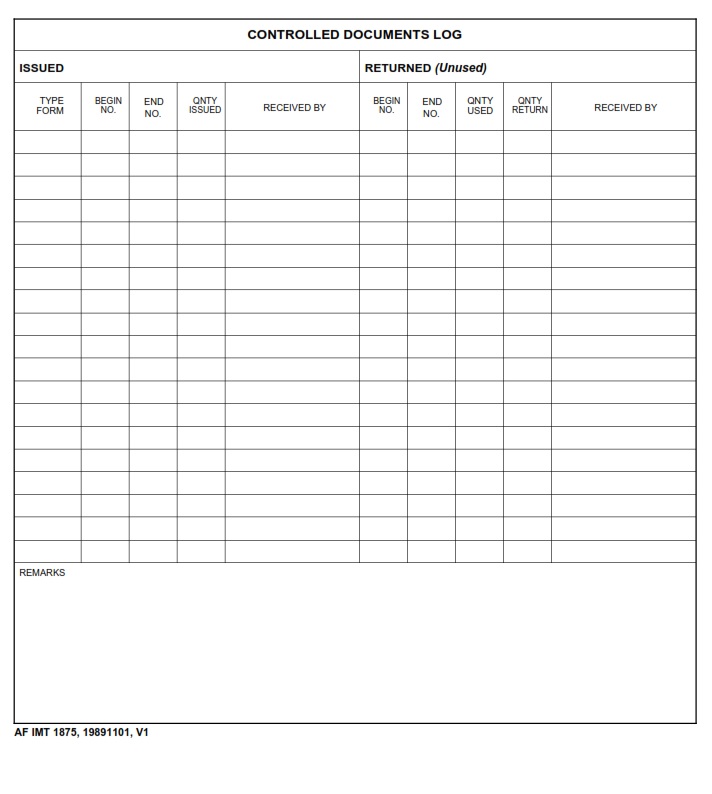AF-FORMS.COM – AF Form 1875PG2 – Controlled Documents Log – Are you ready to dive into the world of top-secret documents and classified information? Imagine a logbook filled with entries detailing the handling and tracking of highly sensitive materials, each page holding the secrets to national security. This is where AF Form 1875PG2 – Controlled Documents Log comes into play, a seemingly mundane yet crucial tool in the intricate web of military operations. As you flip through its pages, you’ll uncover a hidden realm of protocols, safeguards, and meticulous record-keeping that ensure only authorized personnel have access to these prized possessions. Join me on a journey as we unravel the mysteries behind this seemingly ordinary logbook and discover the extraordinary measures taken to protect valuable information in our ever-evolving world of espionage and security breaches.
Download AF Form 1875PG2 – Controlled Documents Log
| Form Number | AF Form 1875PG2 |
| Form Title | Controlled Documents Log |
| Edition Date | 11/1/1989 |
| File Size | 20 KB |
AF-Form-1875PG2-Controlled-Documents-Log.pdf (27 downloads )
What is an AF Form 1875PG2?
Understanding the intricacies of military documentation is crucial, and the AF Form 1875PG2 holds a significant role in this realm. Designed as a Controlled Documents Log, this form serves as a vital tool for tracking and managing important military documents within various departments and units. By meticulously recording details such as document numbers, titles, distribution dates, and recipients’ signatures, the AF Form 1875PG2 enhances accountability and ensures that classified materials are handled with utmost diligence.
Furthermore, the Controlled Documents Log plays a pivotal role in maintaining operational security and confidentiality within military operations. It serves as a safeguard mechanism to prevent unauthorized access or mishandling of sensitive information by providing an extensive trail of who accessed what document and when. Additionally, this form underscores the emphasis on procedural compliance and adherence to strict protocols governing document management within the armed forces. This meticulous approach not only upholds organizational integrity but also reinforces trust among personnel handling critical documents essential for national security objectives.
Where Can I Find an AF Form 1875PG2?
If you’re searching for an AF Form 1875PG2, the first place to look is the official Air Force website. Most forms and documents can be found on their online database, making it a convenient and reliable source for all your administrative needs. Additionally, you may want to check with your unit’s administration office or personnel department as they often have access to these forms and can provide them upon request.
Another option is to utilize digital document management systems that are authorized by the Air Force. These platforms not only ensure secure access to controlled documents like AF Form 1875PG2 but also provide tracking and logging capabilities that enhance document control within military environments. By leveraging technology solutions, individuals can streamline their processes when working with such critical paperwork, improving efficiency and compliance in document handling procedures.
AF Form 1875PG2 – Controlled Documents Log
As organizations strive to maintain order and accountability within their operations, the use of controlled document logs such as the AF Form 1875PG2 becomes crucial. This log serves as a meticulous record-keeping tool for tracking important documents that require heightened security measures. By logging details such as document title, control number, custodian information, and access permissions, the form ensures that only authorized personnel have access to sensitive information.
Moreover, the Controlled Documents Log plays a pivotal role in enhancing compliance with regulatory requirements and safeguarding confidential data from unauthorized disclosure. It acts as a gatekeeper for critical documents, ensuring that they are properly secured and managed throughout their lifecycle. This level of precision not only bolsters organizational efficiency but also instills confidence among stakeholders regarding the handling of sensitive materials. In essence, this seemingly mundane form serves as a guardian of vital information within complex bureaucratic structures.
